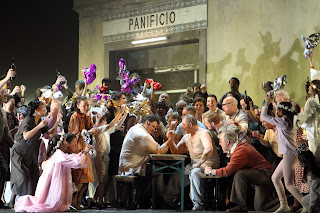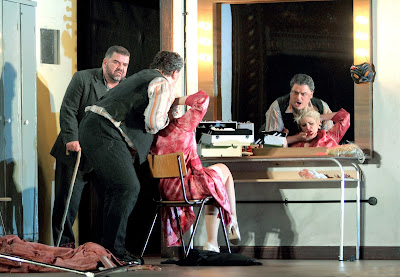 |
| Dimitri Platanias, members of the Royal Opera Chorus and the Alfa Giulietta Cavalleria Rusticana - Royal Opera House - (c)ROH, photo Catherine Ashmore |
Reviewed by Robert Hugill on Dec 03 2015
Star rating:
Cav and Pag updated to the 1980's with some strongly musical and dramatic performances
 |
| Cavalleria Rusticana (c)ROH, photo Catherine Ashmore |
 |
| Pagliacci - Carmen Giannattasio, Benjamin Hulett, Dimitri Platanias, Aleksandrs Antonenko - (c) ROH. Photographer Catherine Ashmore |
Michieletto and his designers, Paolo Fantin and Carla Teti, seem to have been inspired to a certain extent by Italian realist cinema. Certainly the production, with its extensive use of the revolve, kept the action moving in a very filmic way. The setting was the late 20th century; Alfio's car in Cavalleria Rusticana was a 1985/86 Alfa Giulietta model, quite a rare care nowadays (it seemed to be on Madrid number plates which may have been a comment about the extent of Alfio's journeyings).
 |
| Mama Lucia's bakery, Cavalleria Ruticana - Dionysios Sourbis (C) ROH. Photographer Catherine Ashmore |
The production had a two or three distinctive pensées. The prelude started with the depiction of the murder of a young man (whilst Turiddu was singing to Lola off-stage), and the whole production cycled round to the depiction of Turiddu's murder in exactly the same scene as if the events depicted were simply part of a common cycle. During the Easter Hymn the villagers carried a statue of the Virgin Mary, at one point the lighting changed and the villagers froze, whilst Santuzza (Eva-Maria Westbroek) implored the Virgin. The statue came to life and pointed at Santuzza implacably. Then during the Intermezzo we saw Nedda from Pagliacci (Carmen Giannattasio) putting up posters for Pagliacci and flirting with one of the men from the bakery, who would prove to be her lover Silvio (Dionysios Sourbis). This cross linking was carried through into Pagliacci when during the intermezzo there we saw Santuzza in tears talking to a priest and apparently pregnant and then meeting Mama Lucia. I found this cross-linking disturbing and unsatisfactory. The two operas have no real link apart from a commonality of style, and during one opera the last thing we want is to be thinking about characters in the other one. Frankly, it felt as if Michieletto had interpolated a bit of Mascagni into Leoncavallo's opera and vice versa.
 |
| Pagliacci - Aleksandrs Antonenko, Carmen Giannattasio (C) ROH. Photographer Catherine Ashmore |
I wasn't sure whether the rather twee costume drama that the actors were presenting as a play within the opera really worked in terms of the 1980's setting. The problem with espousing realism is that it makes your viewers wonder about details like this. Certainly the villagers enthusiasm for the players seemed over the top in context.
 |
| Cavalleria Rusticana - Elena Zilio, Aleksandrs Antonenko (C) ROH. Photographer Catherine Ashmore |
One problem in both operas though, was that Michieletto took both operas' casual misogyny at face value. I have seen productions which make Santuzza a far stronger figure, but here she accepts her role as the penitent Magdalene with no equivalent castigation of Turiddu. In Pagliacci all three men in Nedda's life treat her as their possession. Beppe's intensity suggests that if Nedda goes with him she will be replacing the possessiveness of Canio with that of another man, and of course because Tonio can't have her he rapes her. It is possible to rectify these attitudes by making Santuzza and Nedda stronger, without too much violence to the plot but Michieletto seemed content not to.
 |
| Pagliacci - Dimitri Platanias, Aleksandrs Antonenko, Carmen Giannattasio (C) ROH. Photographer Catherine Ashmore |
 |
| Cavalleria Rusticana - (C) ROH. Photographer Catherine Ashmore |
The Royal Opera Chorus played a big role in both operas, creating a real sense of character in the village. There was little of the staginess that this can sometimes bring, and instead there really were moments when you felt this was an Italian realist film. They combined this with some great, firm tone and superbly vivid singing.
The Royal Opera Orchestra were also on form, from the very opening notes of the prelude to Cavalleria Rusticana they created something powerful yet subtle. Antonio Pappano has only recently started to conduct more Italian opera at Covent Garden, and here he showed us what he is capable of, making the music seem fresh and beautifully shaped, letting the melodies flow without it coming over as a hackneyed barn-stormer of an evening.
There was an interestingly traditional edge to Damiano Michieletto's take on Cav and Pag and whilst I could not see the point of explicitly linking the two operas, the performances the he, Pappano and the cast achieved were so strong that this became an evening of real music drama.
(Click on any of the images to see a large scale version of them)
Elsewhere on this blog:
- Late night Piazzolla: Tango Embrace - CD review
- Inspired by Goethe: Dorottya Lang & Helmut Deutsch - concert review
- Unjustly neglected: Elizabeth Watts in arias by Alessandro Scarlatti - CD review
- Challenging yet fascinating: Haas Morgen und Abend - opera review
- Cool & atmospheric: Christiane Karg & Graham Johnson in Schubert - concert review
- Capturing hearts: Ermonela Jaho as Leoncavallo's Zaza with Opera Rara - opera review
- Deft lightness: Gounod's La Colombe - Cd review
- Thomas Tallis: Chronology, Contexts, Discoveries conference at Sidney Sussex College - conference report
- Birthday treats: Roderick Williams & Florilegium at the Wigmore Hall - concert review
- Schubert, Beethoven, Mozart, Spohr: Der Hirt auf dem Felsen - concert review
- Schubert, Chopin, Brahms, Schumann: Der Hirt auf dem Felsen - CD review
- Difficult to imagine it being done better: Mozart's Il Re Pastore - CD review
- Stylistic dichotomy: Gluck's Orfeo from Laurence Equilbey & Franco Fagioli - CD review
- Home







%20as%20Leporello%20and%20Erik%20Tofte%20(back%20to%20camera%20in%20garnet%20shirt)%20as%20Giovanni%20-%20Don%20Giovanni.jpg)



A review of AA's Met performance as Otello said "his signing is wildly inconsistent, with a hard unromantic timbre and an unreliable sense of pitch". That accurately nails how he sang in Cav and Pag, albeit I am not sure his sense of pitch was unreliable ; in Cav it was non existent. It actually overshadowed all else unhappily.
ReplyDelete